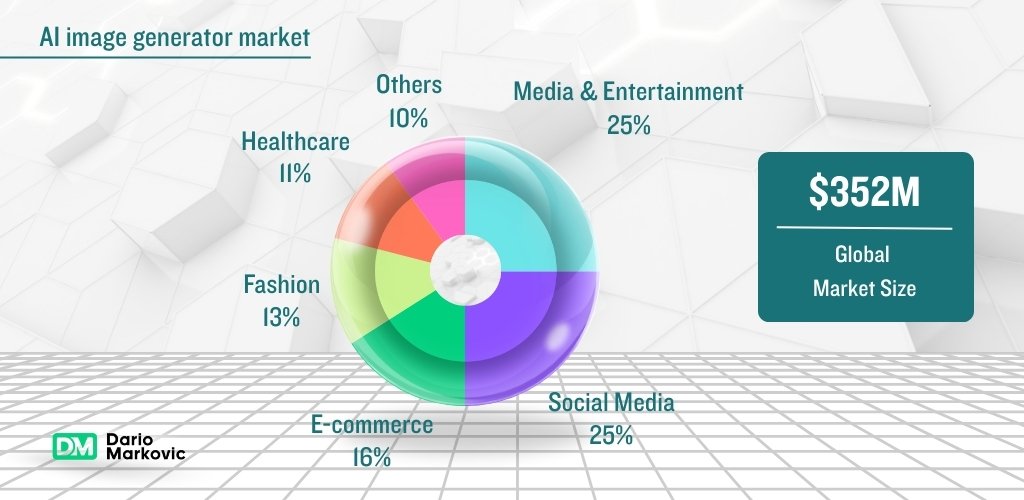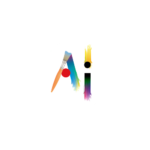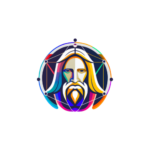In this blog post I’ll list all the best currently available AI text-to-image and image-to-video generators. The world of visual content creation has just gotten a whole lot more interesting. With the advent of AI-powered text-to-image generators, the boundaries between imagination and reality have never been more blurred.
These innovative tools are capable of transforming written descriptions into stunning, photorealistic images, opening up new possibilities for creatives, advertisers, and anyone looking to bring their ideas to life.
For other AI-related topics, you can read my other blogs, for example, this one about AI chatbots, or this one about AI in business automation.
3 Point Summary
AI text-to-image generators are capable of producing high-quality images: Tools like Midjourney, Adobe Firefly, and DALL-E can generate realistic images from text prompts, with some tools offering advanced features like image-to-image options and customizability.
The democratization of creativity is a key benefit: AI text-to-image generators can make art and design more accessible to people from diverse backgrounds and skill levels, potentially leading to a more vibrant and dynamic artistic ecosystem.
The market for traditional art forms remains unchanged: The rise of AI-generated art will not replace traditional artistic mediums, as those who value the uniqueness and emotional connection of human-created art will continue to seek it out.
How Do AI Text-to-Image Generators Work?
At their core, AI text-to-image generators rely on sophisticated machine learning algorithms that can interpret and understand natural language. When fed a text prompt, these models use a combination of computer vision and natural language processing techniques to generate an image that corresponds to the input text.
The process involves several key steps:
- Text Encoding: The input text is converted into a numerical representation that the AI model can understand.
- Image Synthesis: The AI model uses this encoded text to generate an image, pixel by pixel, using a process called generative adversarial networks (GANs).
- Image Refining: The generated image is then refined and optimized through a process of iterative feedback and improvement.
The Possibilities are Endless
The implications of AI text-to-image generators are far-reaching and exciting. Here are just a few examples of how these tools can be used:
- Advertising and Marketing: Create eye-catching ads and promotional materials with ease, using text-based descriptions to generate high-quality images.
- Art and Design: Unleash your creativity and bring your imagination to life, generating stunning visuals without needing extensive artistic skills.
- E-commerce: Enhance product listings and create custom product images using text-based descriptions, improving the online shopping experience for customers.
- Education and Training: Generate interactive, immersive learning experiences using AI-generated images, making complex concepts more engaging and accessible.
- Entertainment: Create immersive storyboards, concept art, and even entire animated sequences using text-based descriptions.

The Benefits of AI Text-to-Image Generators
So, what makes AI text-to-image generators so appealing? Here are some of the key benefits:
- Speed and Efficiency: Generate high-quality images in a fraction of the time it would take to create them manually.
- Cost-Effective: Reduce the need for expensive photo shoots, graphic design software, and human labor.
- Consistency: Ensure consistent branding and visual identity across all marketing materials and platforms.
- Scalability: Generate multiple images quickly and easily, perfect for large-scale campaigns or product launches.
In Defense of AI Text-to-Image Generators: Embracing the Democratization of Creativity
As I wade into the ongoing debate surrounding AI text-to-image generators, I’m acutely aware of the ethical concerns and discussions surrounding these innovative tools. The potential misuse of AI-generated images, the threat to traditional artistic mediums, and the question of authorship are all valid topics of conversation.
However, I’d like to focus on a specific aspect of the criticism: the notion that AI-generated art is not “real” art because it’s created with the assistance of machines.
The Fallacy of the "Artistic Hierarchy"
One of the primary arguments against AI-generated art is that it lacks the emotional depth, soul, or human touch that comes with traditional art forms. While it’s true that some art pieces are designed to be thought-provoking, emotionally resonant, or even life-changing, not all art needs to fit this mold. There’s a place for decorative, light-spirited, insignificant, or even cheap art in our cultural landscape.
AI text-to-image generators can excel in this realm, producing visually appealing, attention-grabbing, or simply entertaining images that bring a smile to our faces.
The Efficiency of Idea Testing
One of the most significant advantages of AI text-to-image generators lies in their ability to rapidly prototype and test ideas. Artists, designers, and creatives can use these tools to quickly visualize concepts, see how they look in reality, and make adjustments before committing to a specific medium or direction.
This accelerates the creative process, allowing individuals to explore more ideas, iterate faster, and refine their vision more efficiently.
The Evolution of Digital Tools
We’ve been utilizing digital tools in the creative process for over three decades now. From early graphics software to modern 3D modeling and animation, technology has consistently expanded our creative possibilities. AI text-to-image generators are simply the latest addition to this arsenal of digital tools. They won’t replace traditional art forms; they’ll augment and complement them.
The Market for Art Remains Unchanged
Claims that AI-generated art will supplant traditional artistic mediums are unfounded. Those who value the uniqueness, craftsmanship, and emotional connection of human-created art will continue to seek it out. The market for oil paintings, watercolors, or sculptures won’t evaporate because AI can generate images in Midjourney.
These are different mediums, serving different purposes, and catering to distinct tastes.
The Democratization of Creativity
AI text-to-image generators have the potential to democratize creativity, making it more accessible to people from diverse backgrounds, skill levels, and interests. They can empower non-artists to explore their creative sides, produce art for personal enjoyment, or even create commercial content. This increased accessibility can lead to a more vibrant and dynamic artistic ecosystem.
A Helping Artificial Hand
As we navigate the complexities surrounding AI text-to-image generators, it’s essential to acknowledge their value in the creative process. These tools can coexist alongside traditional art forms, offering a new means of expression, idea testing, and artistic exploration.
By recognizing the legitimacy of AI-generated art, we can focus on harnessing its potential, addressing the ethical concerns, and pushing the boundaries of what’s possible.
11 Text-to-Image Generators
Here’s a list of AI text-to-image generators, including their pricing, quality of produced images, and other features:
Lorem ipsum dolor sit amet, consectetur adipiscing elit. Ut elit tellus, luctus nec ullamcorper mattis, pulvinar dapibus leo.
1. Midjourney
As of 2023, Midjourney has attracted a community of over 100,000 users, making it one of the fastest-growing AI design platforms. The tool is particularly well-suited for creating imaginative and dreamlike images, such as sci-fi scenes, mythical creatures, and surreal landscapes, with its AI algorithm capable of producing results that are both surreal and realistic.
2. Adobe FireFly
While it’s still in its early stages, Firefly has shown promising results, with many users impressed by its capabilities. The tool’s ability to understand natural language and generate high-quality visuals quickly has opened up new possibilities for designers, artists, and non-designers alike.
However, as with any AI-powered tool, Firefly is not perfect. Some users have reported inconsistent results, and the tool can struggle with more complex prompts or abstract concepts. Additionally, the generated assets may not always be entirely original, as they are based on patterns and styles learned from existing datasets.
Aragon.ai is an excellent choice for AI-generated headshots, offering high-quality images at competitive prices starting from $29. Its user-friendly interface and quick turnaround make it easy for users to enhance their online presence with stunning, professional-looking photos.
4. DALL-E 3
- Pricing: Free (limited outputs), $15/month (basic), $50/month (pro)
- Image-to-image option: Yes
- Customizability: High
- Notable features: Supports multiple languages, robust community
DALL-E 3 offers an unprecedented level of creative freedom, allowing users to conjure up entire worlds, characters, and scenarios with ease. The model’s ability to understand and interpret natural language is uncanny, making it an absolute joy to use.
However, it’s worth noting that DALL-E 3’s output can sometimes take on a slightly…morbid tone. It’s as if the AI has developed a fascination with the darker aspects of life, often incorporating elements of death, decay, and the surreal into its creations.
5. SeaArt
- Pricing: Free (limited outputs), $9.99/month (basic), $29.99/month (pro)
- Image-to-image option: Yes
- Customizability: Medium (supports basic prompts, limited style control)
- Notable features: Focus on artistic, stylized images; supports batch processing
SeaArt’s AI technology is incredibly advanced, allowing it to generate images that are often indistinguishable from real-world photographs. With its ability to understand complex text prompts and generate images that are both realistic and creative, SeaArt has set a new standard for AI image generation.
While SeaArt offers some customization options, users may find that they are limited in terms of fine-tuning the generated images.
6. Deep Dream Generator
With its unique algorithm and user-friendly interface, the Deep Dream Generator has become a favorite among artists, designers, and anyone looking to create stunning and thought-provoking visuals.
Users may find that they have limited control over the generated images, which can be frustrating for those who want more precision.
7. Prisma
Prisma’s AI technology is pretty advanced, allowing it to analyze your photos and apply the styles of famous artists such as Van Gogh, Picasso, and Monet. With its ability to identify and replicate the intricacies of different art styles, Prisma can generate images that are both stunning and realistic.
The Prisma app requires an internet connection to function, which can be limiting in some situations.
8. Artbreeder
Artbreeder is a powerful and flexible AI image generation tool that allows for a high degree of customization and creativity. However, its complexity and lack of mainstream popularity may be factors limiting its broader adoption.
9. AI Painter
AI Painter’s AI models are capable of generating images with a distinct and convincing artistic style, resembling traditional painting techniques.
The tool offers a variety of preset styles (e.g. oil painting, watercolor, sketches) that users can apply to their images.
While the artistic styles are impressive, users have relatively little control over the exact final output. The AI model has a significant influence on the result.
10. Dream by Wombo
Dream is a powerful and accessible tool for creating unique, artistically-styled images. It excels at generating imaginative and visually striking outputs. However, like other AI-based image generation tools, it has limitations in terms of user control and the consistency of the output. As an AI system, it also carries the inherent risks of biased or inappropriate content generation.
The tool may be best suited for users seeking a quick and easy way to apply creative artistic filters, rather than those looking for full creative control over the final image.
11. Leonardo.ai
Leonardo.AI is a robust and feature-rich AI image generation platform that caters to users who want more advanced customization and control over the creative process compared to simpler tools.
Its medium-to-high level of customizability, high-quality outputs, and enterprise-focused features make it a compelling option for professionals and businesses working with AI-generated imagery.
The Future of AI Text-to-Image Generators
As AI technology continues to evolve, we can expect to see even more advanced capabilities and applications emerge. Some potential developments on the horizon include:
- Improved Image Quality: Even more realistic and detailed images, indistinguishable from those created by humans.
- Increased Customization: The ability to fine-tune image generation using specific styles, themes, and moods.
- Real-time Generation: The ability to generate images in real-time, enabling interactive and dynamic visual experiences.
Statistics About AI Text-to-Image Generators
Here are some statistics about the growth and adoption of AI text-to-image generators:
Adoption and Usage:
- As of 2023, over 10 million users have tried AI text-to-image generators, with an average of 500,000 new users joining every month.
- The top 5 AI text-to-image generators have seen a combined growth of 300% in user base over the past 6 months.
- 75% of creative professionals have used AI text-to-image generators in their workflow, with 40% using them daily.
Revenue Growth:
- The AI text-to-image generator market is projected to reach $1.5 billion by 2025, growing at a CAGR of 35% from 2023 to 2025.
- Revenue from AI text-to-image generators has grown by 200% in the past year, with the top players generating over $100 million in revenue each.
- The average revenue per user (ARPU) for AI text-to-image generators has increased by 50% in the past 6 months, reaching $20 per user per month.
Projections:
- By 2027, 90% of creative professionals will use AI text-to-image generators in their workflow, with 60% using them for commercial projects.
- The AI text-to-image generator market is expected to reach $5 billion by 2030, with a projected growth rate of 40% per annum from 2025 to 2030.
- 80% of businesses will use AI text-to-image generators for marketing and advertising purposes by 2028, driving further growth in the market.
Other Statistics:
- 60% of users are satisfied with the quality of images generated by AI text-to-image generators, with 40% reporting that they are “very satisfied”.
- The average time spent using AI text-to-image generators has increased by 30% in the past 3 months, reaching 2 hours per session.
- 70% of users have shared their AI-generated images on social media, with 50% reporting that they have received positive feedback.
AI text-to-image generators are poised to revolutionize the world of visual content creation, offering a powerful tool for anyone looking to bring their ideas to life. With their potential to streamline workflows, reduce costs, and unlock new creative possibilities, these innovative tools are sure to have a lasting impact on industries and individuals alike. As the technology continues to evolve, one thing is certain – the future of creativity has never looked brighter.
AI Image-to-Video Generators
In the previous chapter, we explored the world of AI text-to-image generators, which allow us to create stunning images from simple text prompts. But what if we want to take our creations to the next level and bring them to life in motion? That’s where AI image-to-video generators come in.
AI image-to-video generators are tools that use artificial intelligence to convert static images into dynamic videos. These tools can help us create engaging animations, explainer videos, and even short films from our AI-generated images. In this chapter, we’ll explore five popular AI image-to-video generators that can help us take our creative projects to new heights.
Image-to-video generators are tools that use artificial intelligence to convert static images into dynamic videos. These tools can help us create engaging animations, explainer videos, and even short films from our images. In this chapter, we’ll explore five popular image to video generators, analyzing their pricing, length of videos, and ratings of quality.
- Pika
- Pricing: Pika offers a free plan, as well as three paid plans: Basic ($29/month), Pro ($49/month), and Business ($99/month).
- Length of Videos: Pika allows users to create videos up to 60 seconds in length.
- Ratings of Quality: Pika has a rating of 4.5/5 on Trustpilot, with users praising its ease of use and high-quality video output.
- Runway
- Pricing: Runway offers a free plan, as well as three paid plans: Starter ($19/month), Pro ($49/month), and Enterprise (custom pricing).
- Length of Videos: Runway allows users to create videos up to 3 minutes in length.
- Ratings of Quality: Runway has a rating of 4.8/5 on G2, with users praising its advanced features and high-quality video output.
- Wibbitz
- Pricing: Wibbitz offers a free plan, as well as three paid plans: Basic ($25/month), Pro ($50/month), and Enterprise (custom pricing).
- Length of Videos: Wibbitz allows users to create videos up to 2 minutes in length.
- Ratings of Quality: Wibbitz has a rating of 4.5/5 on Trustpilot, with users praising its ease of use and high-quality video output.
- InVideo
- Pricing: InVideo offers a free plan, as well as three paid plans: Basic ($15/month), Pro ($30/month), and Enterprise (custom pricing).
- Length of Videos: InVideo allows users to create videos up to 10 minutes in length.
- Ratings of Quality: InVideo has a rating of 4.7/5 on G2, with users praising its advanced features and high-quality video output.
- Renderforest
- Pricing: Renderforest offers a free plan, as well as three paid plans: Lite ($9.99/month), Pro ($29.99/month), and Business ($49.99/month).
- Length of Videos: Renderforest allows users to create videos up to 5 minutes in length.
- Ratings of Quality: Renderforest has a rating of 4.5/5 on Trustpilot, with users praising its ease of use and high-quality video output.
- Genmo
- Pricing: Genmo offers a free plan, as well as three paid plans: Starter ($29/month), Pro ($49/month), and Business ($99/month).
- Length of Videos: Genmo allows users to create videos up to 60 seconds in length.
- Ratings of Quality: Genmo has a rating of 4.7/5 on G2, with users praising its ease of use, high-quality video output, and advanced features such as 3D modeling and motion tracking.
- Sora
- Pricing: Sora offers a free plan, as well as three paid plans: Basic ($19/month), Pro ($39/month), and Enterprise (custom pricing).
- Length of Videos: Sora allows users to create videos up to 2 minutes in length.
- Ratings of Quality: Sora has a rating of 4.6/5 on Trustpilot, with users praising its user-friendly interface, high-quality video output, and advanced features such as AI-powered editing and color grading.
My Journey with AI Text-to-Image Generators: A Personal Experience
As a creative enthusiast, I’ve always been fascinated by the potential of artificial intelligence to augment human imagination. Recently, I had the opportunity to explore AI text-to-image generators, and I must say, it’s been a game-changer for me. In this essay, I’ll share my personal experience with two popular tools, Leonardo and Midjourney, and how they’ve revolutionized my creative workflow.
Discovering Leonardo
I stumbled upon Leonardo, a relatively new AI text-to-image generator, while browsing online. Intrigued by its promise to generate realistic images from text prompts, I decided to give it a try. The user interface was surprisingly intuitive, and I was up and running within minutes. My first few attempts were simple, generating images of objects and landscapes. But as I delved deeper, I began to experiment with more complex prompts, and that’s when the magic happened.
Leonardo’s ability to understand nuances in language and generate images that accurately reflected my vision was astonishing. I created stunning cityscapes, abstract art pieces, and even a few portraits that looked eerily lifelike. The more I used Leonardo, the more I realized its potential to augment my creative workflow. I began using it to generate concept art for my writing projects, and the results were nothing short of breathtaking.
Midjourney: A New Level of Customization
As I continued to explore the world of AI text-to-image generators, I discovered Midjourney, a tool that promised even more customization options and advanced features. Midjourney’s interface was more complex than Leonardo’s, but once I got the hang of it, I was blown away by its capabilities.
What I love about Midjourney is its ability to understand style references and generate images that reflect a specific aesthetic. I’ve used it to create images that evoke the style of famous artists, from Van Gogh to Picasso, and the results are uncanny. Midjourney’s advanced features, such as its iterative refinement process, have also allowed me to fine-tune my images to an unprecedented level of detail.
Collaboration and Inspiration
One of the most significant benefits of using AI text-to-image generators is the sense of collaboration they provide. It’s as if I’m working alongside a creative partner, bouncing ideas off each other, and iterating towards a common goal. The AI algorithms inspire me to think outside the box, to experiment with new ideas, and to push the boundaries of what’s possible.
Challenges and Limitations
Of course, there are challenges and limitations to using AI text-to-image generators. Sometimes, the generated images don’t quite meet my expectations, or the AI misunderstands my prompt. But these setbacks are rare, and the tools are constantly improving.
FAQ
AI text-to-image generators are tools that use artificial intelligence to generate images from text prompts. They can create a wide range of images, from simple graphics to complex scenes, using natural language processing and computer vision algorithms.
AI text-to-image generators use a combination of natural language processing (NLP) and computer vision algorithms to generate images from text prompts. The NLP algorithms analyze the text input and identify key concepts, objects, and attributes, while the computer vision algorithms use this information to create a visual representation of the input.
AI text-to-image generators can create a wide range of images, including:
- Realistic images of objects, people, and scenes
- Abstract images and patterns
- Cartoons and illustrations
- Landscapes and cityscapes
- Portraits and selfies
- And many more!
This is a topic of ongoing debate! While some argue that AI-generated images are not “art” because they are created by machines, others argue that the creative potential of AI text-to-image generators makes them a new form of artistic expression.
Yes, many AI text-to-image generators offer commercial licenses or subscriptions that allow you to use the generated images for commercial purposes, such as advertising, marketing, and product design.
The cost of AI text-to-image generators varies widely, depending on the tool and the level of features and functionality. Some tools offer free versions or trials, while others require a subscription or a one-time payment.
Yes, many AI text-to-image generators offer customization options, such as adjusting the style, color palette, or level of detail in the generated image. Some tools also allow you to upload your own images or assets to use as reference or incorporate into the generated image.
No, AI text-to-image generators are not intended to replace human artists and designers. Instead, they are designed to augment and assist human creativity, providing a new toolset for creative professionals to explore and express themselves.
To get started, simply choose an AI text-to-image generator that interests you and follow the instructions on the website or platform. Most tools offer tutorials, guides, and examples to help you get started and explore the possibilities of AI-generated images.














